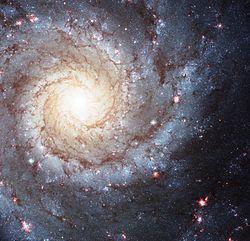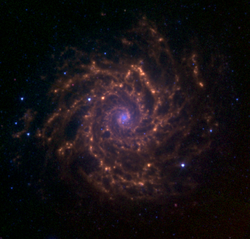- Messier 74
-
Messier 74 
Observation data (J2000 epoch) Constellation Pisces[1] Right ascension 01h 36m 41.8s[2] Declination +15° 47′ 01″[2] Redshift 657 km/s[2] Distance 30 ± 6 Mly[3] Type SA(s)c[2] Apparent dimensions (V) 10′.5 × 9′.5[2] Apparent magnitude (V) 10.0[2] Other designations NGC 628, UGC 1149, PGC 5974[2] See also: Galaxy, List of galaxies Messier 74 (also known as NGC 628) is a face-on spiral galaxy in the constellation Pisces. It is at a distance of about 32 million light-years away from Earth.[4] The galaxy contains two clearly defined spiral arms and is therefore used as an archetypal example of a Grand Design Spiral Galaxy.[5] The galaxy's low surface brightness makes it the most difficult Messier object for amateur astronomers to observe.[6][7] However, the relatively large angular size of the galaxy and the galaxy's face-on orientation make it an ideal object for professional astronomers who want to study spiral arm structure and spiral density waves. It is estimated that M74 is home to about 100 billion stars.[4]
Contents
History
M74 was discovered by Pierre Méchain in 1780. Méchain then communicated his discovery to Charles Messier, who listed the galaxy in his catalog.[7]
Supernovae
Two supernovae have been identified in M74:[2] SN 2002ap[8] and SN 2003gd.[9]
SN 2002ap has attracted considerable attention because it is one of the few Type Ic supernovae (or hypernovae) observed within 10 Mpc in recent years.[10][11][12] This supernovae has been used to test theories on the origins of similar Type Ic supernovae at higher distances[11] and theories on the connection between supernovae and gamma ray bursts.[12]
SN 2003gd is a Type II-P supernova.[13] Type II supernovae have known luminosities, so they can be used to accurately measure distances. The distance measured to M74 using SN 2003gd is 9.6 ± 2.8 Mpc, or 31 ± 9 million ly.[3] For comparison, distances measured using the brightest supergiants are 7.7 ± 1.7 Mpc and 9.6 ± 2.2 Mpc.[3] Ben E. K. Sugerman found a "light echo" - a reflection of supernova explosion that appeared after the explosion itself - associated with SN 2003gd.[14] This is one of the few supernovae in which such a reflection has been found. This reflection appears to be from dust in a sheet-like cloud that lies in front of the supernova, and it can be used to determine the composition of the interstellar dust.[14][15]
Galaxy group information
M74 is the brightest member of the M74 Group, a group of 5-7 galaxies that also includes the peculiar spiral galaxy NGC 660 and a few irregular galaxies.[16][17][18] Although different group identification methods may consistently identify many of the same member galaxies in this group,[18] the exact group membership is still uncertain.
Star formation
 M74 as observed with the Spitzer Space Telescope as part of the Spitzer Infrared Nearby Galaxy Survey. The blue colors represent the 3.6 micrometre emission from stars. The green and red colors represent the 5.8 and 8.0 micrometre emission from polycyclic aromatic hydrocarbons and possibly dust.
M74 as observed with the Spitzer Space Telescope as part of the Spitzer Infrared Nearby Galaxy Survey. The blue colors represent the 3.6 micrometre emission from stars. The green and red colors represent the 5.8 and 8.0 micrometre emission from polycyclic aromatic hydrocarbons and possibly dust.
Suspected black hole
On March 22, 2005, it was announced [19] that the Chandra X-ray Observatory had observed an ultraluminous X-ray source (ULX) in M74, radiating more X-ray power than a neutron star in periodic intervals of around two hours. It has an estimated mass of around 10,000 Suns. This is an indicator of an intermediate-mass black hole. This would be a rather uncommon class of black holes, somewhere in between in size of stellar black holes and the massive black holes theorized to reside in the center of many galaxies. Because of this, they are believed to form not from single supernovae, but possibly from a number of lesser stellar black holes in a star cluster. The X-ray source is identified as CXOU J013651.1+154547.
Amateur astronomy observation information
Messier 74 is located 1.5° east-northeast of Eta Piscium.[6][7] This galaxy has the second lowest surface brightness of all the Messier objects. (M101 has the lowest.) It may be very difficult to see unless the sky is dark and clear,[7] and it may be difficult to see in locations affected by light pollution.[6] This galaxy may be best viewed under low magnification; when highly magnified, the diffuse emission becomes more extended and appears too faint to be seen by many people.[7] Additionally, M74 may be more easily seen when using averted vision when the eyes are fully dark adapted.[6][7]
See also
- NGC 3184 - a similar face-on spiral galaxy
- Messier 101 - a similar face-on spiral galaxy
- Whirlpool Galaxy - a well-known face-on spiral galaxy
- Messier 74 on WikiSky: DSS2, SDSS, GALEX, IRAS, Hydrogen α, X-Ray, Astrophoto, Sky Map, Articles and images
References
- ^ R. W. Sinnott, ed (1988). The Complete New General Catalogue and Index Catalogue of Nebulae and Star Clusters by J. L. E. Dreyer. Sky Publishing Corporation / Cambridge University Press. ISBN 0-933-34651-4.
- ^ a b c d e f g h "NASA/IPAC Extragalactic Database". Results for NGC 628. http://nedwww.ipac.caltech.edu/. Retrieved 2006-08-12.
- ^ a b c M. A. Hendry, S. J. Smartt, J. R. Maund, A. Pastorello, L. Zampieri, S. Benetti, M. Turatto, E. Cappellaro, W. P. S. Meikle, R. Kotak, M. J. Irwin, P. G. Jonker, L. Vermaas, R. F. Peletier, H. van Woerden, K. M. Exter, D. L. Pollacco, S. Leon, S. Verley, C. R. Benn, G. Pignata (2005). "A study of the Type II-P supernova 2003gd in M74". Monthly Notices of the Royal Astronomical Society 359 (3): 906–926. arXiv:astro-ph/0501341. Bibcode 2005MNRAS.359..906H. doi:10.1111/j.1365-2966.2005.08928.x.
- ^ a b "Astronomy Picture of the Day , M74: The Perfect Spiral". NASA. 2011-04-06. http://apod.nasa.gov/apod/ap110406.html. Retrieved 2011-04-07.
- ^ A. Sandage, J. Bedke (1994). Carnegie Atlas of Galaxies. Carnegie Institution of Washington. ISBN 0-87279-667-1.
- ^ a b c d S. J. O'Meara (1998). The Messier Objects. Cambridge University Press. ISBN 0-521-55332-6.
- ^ a b c d e f K. G. Jones (1991). Messier's Nebulae and Star Clusters (2nd ed.). Cambridge: Cambridge University Press. ISBN 0-521-37079-5.
- ^ S. Nakano, R. Kushida, Y. Kushida, W. Li (2002). "Supernova 2002ap in M74". IAU Circular 7810: 1. Bibcode 2002IAUC.7810....1N.
- ^ R. Evans, R. H. McNaught (2003). "Supernova 2003gd in M74". IAU Circular 8150: 2. Bibcode 2003IAUC.8150....2E.
- ^ P. A. Mazzali, J. Deng, K. Maeda, K. Nomoto, H. Umeda, K. hatano, K. Iwamoto, Y. Yoshii, Y. Kobayashi, T. Minezaki, M. Doi, K. Enya, H. Tomita, S. J. Smartt, K. Kinugasa, H. Kawakita, K. Ayani, T. Kawabata, H. Yamaoka, Y. L. Qiu, K. Motohara, C. L. Gerardy, R. Fesen, K. S. Kawabata, M. Iye, N. Kashikawa, G. Kosugi, Y. Ohyama, M. Takada-Hidai, G. Zhao, R. Chornock, A. V. Filippenko, S. Benetti, M. Turatto (2002). "The Type Ic Hypernova SN 2002ap". Astrophysical Journal 572 (1): L61–L65. Bibcode 2002ApJ...572L..61M. doi:10.1086/341504.
- ^ a b S. J. Smartt, P. M. Vreeswijk, E. Ramirez-Ruiz, G. F. Gilmore, W. P. S. Meikle, A. M. N. Ferguson, J. H. Knapen (2002). "On the Progenitor of the Type Ic Supernova 2002ap". Astrophysical Journal 572 (2): L147–L151. arXiv:astro-ph/0205241. Bibcode 2002ApJ...572L.147S. doi:10.1086/341747.
- ^ a b A. Gal-Yam, E. O. Ofek, O. Shemmer (2002). "Supernova 2002ap: The first month". Monthly Notices of the Royal Astronomical Society Letters 332 (4): L73–L77. arXiv:astro-ph/0204008. Bibcode 2002MNRAS.332L..73G. doi:10.1046/j.1365-8711.2002.05535.x.
- ^ S. D. Van Dyk, W. Li, A. V. Filippenko (2003). "On the Progenitor of the Type II-Plateau Supernova 2003gd in M74". Publications of the Astronomical Society of the Pacific 115 (813): 1289–1295. arXiv:astro-ph/0307226. Bibcode 2003PASP..115.1289V. doi:10.1086/378308.
- ^ a b B. E. K. Sugerman (2005). "Discovery of a Light Echo from SN 2003gd". Astrophysical Journal Letters 632 (1): L17–L20. arXiv:astro-ph/0509009. Bibcode 2005ApJ...632L..17S. doi:10.1086/497578.
- ^ S. D. Van Dyk, W. Li, A. V. Filippenko (2006). "The Light Echo around Supernova 2003gd in Messier 74". Publications of the Astronomical Society of the Pacific 118 (841): 351–357. arXiv:astro-ph/0508684. Bibcode 2006PASP..118..351V. doi:10.1086/500225.
- ^ R. B. Tully (1988). Nearby Galaxies Catalog. Cambridge University Press. ISBN 0-521-35299-1.
- ^ A. Garcia (1993). "General study of group membership. II - Determination of nearby groups". Astronomy and Astrophysics Supplement 100: 47–90. Bibcode 1993A&AS..100...47G.
- ^ a b G. Giuricin, C. Marinoni, L. Ceriani, A. Pisani (2000). "Nearby Optical Galaxies: Selection of the Sample and Identification of Groups". Astrophysical Journal 543 (1): 178–194. arXiv:astro-ph/0001140. Bibcode 2000ApJ...543..178G. doi:10.1086/317070.
- ^ Chandra :: Photo Album :: M74 :: 22 Mar 05
External links
Messier objects List M1 · M2 · M3 · M4 · M5 · M6 · M7 · M8 · M9 · M10 · M11 · M12 · M13 · M14 · M15 · M16 · M17 · M18 · M19 · M20 · M21 · M22 · M23 · M24 · M25 · M26 · M27 · M28 · M29 · M30 · M31 · M32 · M33 · M34 · M35 · M36 · M37 · M38 · M39 · M40 · M41 · M42 · M43 · M44 · M45 · M46 · M47 · M48 · M49 · M50 · M51 · M52 · M53 · M54 · M55 · M56 · M57 · M58 · M59 · M60 · M61 · M62 · M63 · M64 · M65 · M66 · M67 · M68 · M69 · M70 · M71 · M72 · M73 · M74 · M75 · M76 · M77 · M78 · M79 · M80 · M81 · M82 · M83 · M84 · M85 · M86 · M87 · M88 · M89 · M90 · M91 · M92 · M93 · M94 · M95 · M96 · M97 · M98 · M99 · M100 · M101 · M102 · M103 · M104 · M105 · M106 · M107 · M108 · M109 · M110See also  Book:Messier objects ·
Book:Messier objects ·  Category:Messier objects
Category:Messier objects  Portal:AstronomyCategories:
Portal:AstronomyCategories:- Spiral galaxies
- Unbarred spiral galaxies
- M74 Group
- Pisces constellation
- Messier objects
- NGC objects
- UGC objects
- PGC objects
Wikimedia Foundation. 2010.
